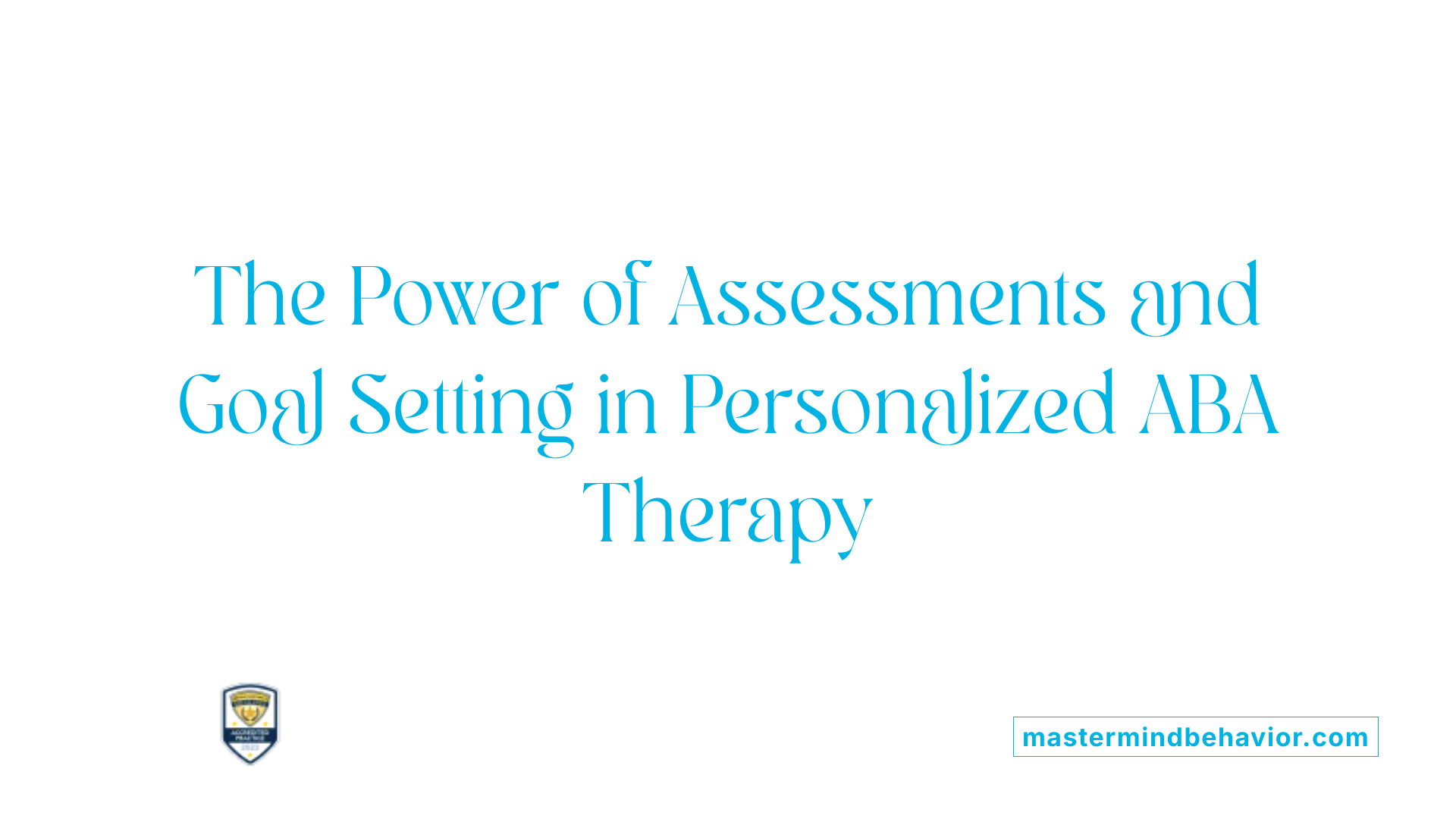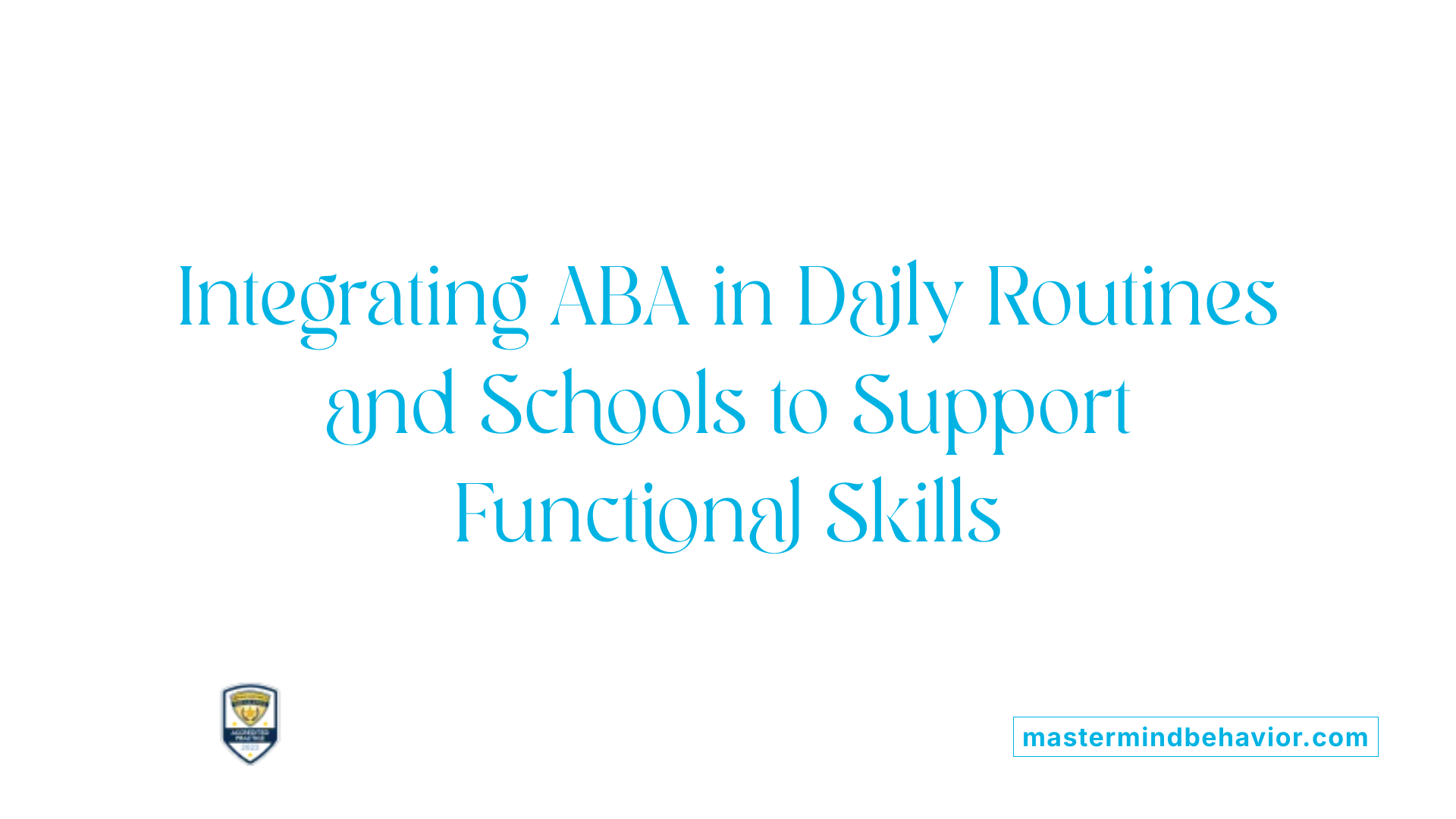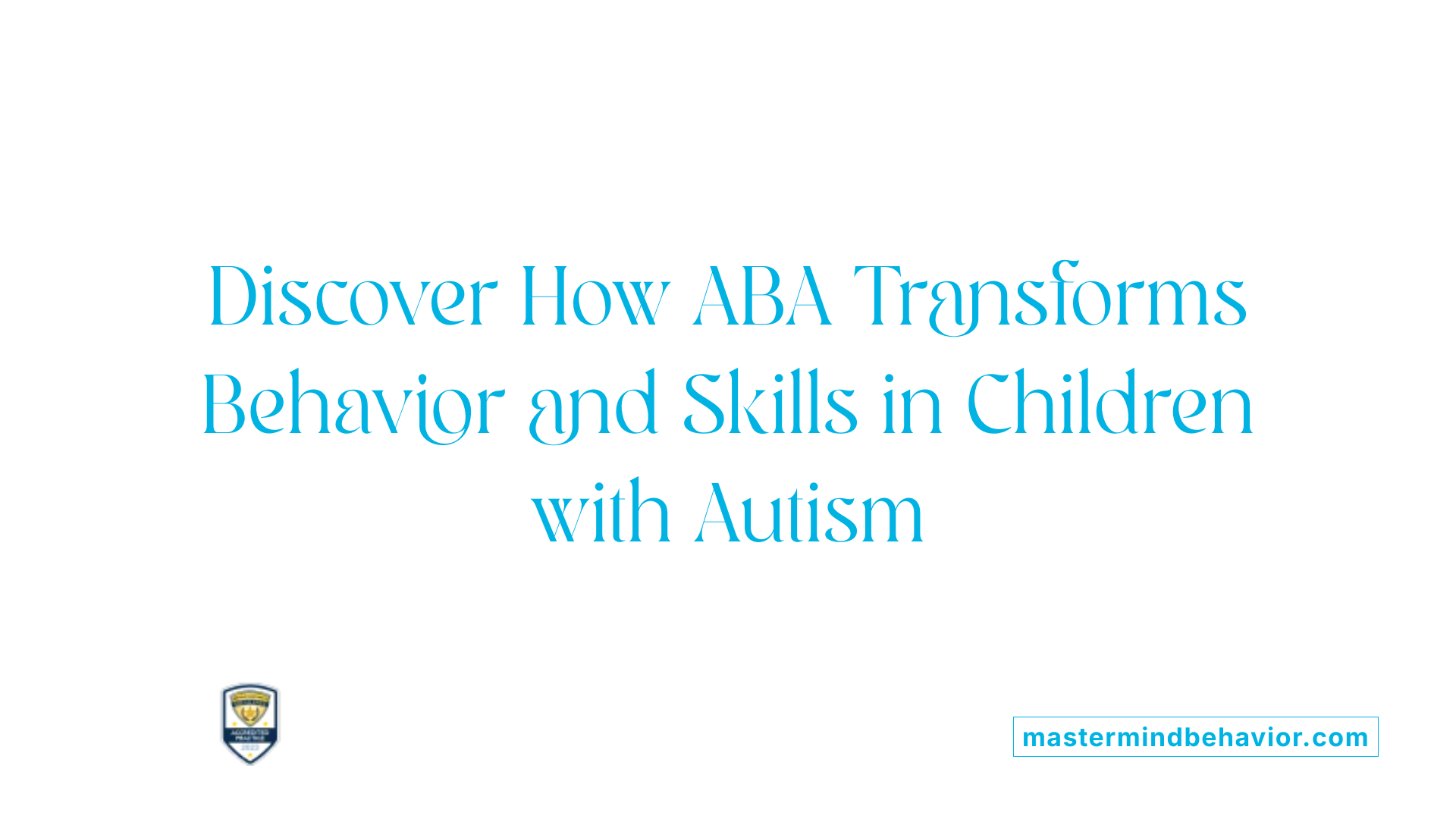Understanding the Impact of ABA Therapy on Autism Spectrum Disorder
Applied Behavior Analysis (ABA) is widely recognized as an effective, evidence-based approach for supporting children with Autism Spectrum Disorder (ASD). Its structured yet adaptable methods aim to foster essential functional skills, reduce maladaptive behaviors, and promote independence. By systematically analyzing behaviors and tailoring interventions, ABA therapy enables meaningful progress across social, communicative, and daily living domains, ultimately enhancing quality of life for children and their families.
Supporting the Development of Functional Behaviors in Children with Autism
How does ABA therapy support the development of functional behaviors in children with autism?
ABA therapy plays a vital role in fostering functional behaviors by employing proven, evidence-based methods. Central to this approach is the use of positive reinforcement, which encourages children to adopt desirable skills such as effective communication, social engagement, and essential daily living activities.
Each child's unique needs are carefully evaluated through assessments, leading to the creation of individualized programs. These programs focus on targeted goals like language development, reducing maladaptive behaviors, and increasing independence.
A key strategy involves breaking down complex skills into small, manageable steps—a process known as task analysis. Consistent application of reinforcement helps children learn and retain new behaviors. Functional behavior assessments identify triggers for problematic behaviors, allowing therapists to plan interventions that modify these behaviors effectively.
By systematically teaching and reinforcing appropriate actions, ABA creates a structured environment that promotes adaptive functioning. This methodical, tailored approach has been shown scientifically to improve developmental outcomes, dramatically enhancing the social, communicative, and practical skills of children with autism.
How does ABA therapy facilitate skill acquisition in children with autism?
Skill development in ASD children is supported through ABA by utilizing customized, evidence-backed techniques such as prompting, data-driven decision-making, and generalization strategies. The therapy often begins with task analysis, which involves deconstructing complex skills into simple, teachable steps.
Children are rewarded for correct responses with positive reinforcement—like stickers or praise—to motivate ongoing learning. Prompts are gradually faded as children become more independent, fostering confidence and self-sufficiency.
Assessment and ongoing data collection help therapists monitor progress precisely, making adjustments to suit each child's evolving needs. Parental involvement is also crucial; training families ensures that learned skills are reinforced across different settings, promoting consistency and skill generalization.
Through these strategies, ABA helps develop critical communication skills, improve social interactions, and enhance self-care routines such as dressing, grooming, and eating. The result is an increase in independence and a better quality of life for children with autism.
Techniques used in ABA to support behavior development
- Positive reinforcement (rewards, praise)
- Prompting and fading
- Discrete trial training
- Natural environment training
- Verbal behavior therapy
- Functional behavior assessment
Assessment methods in ABA for personalized intervention
| Method | Purpose | Detail |
|---|---|---|
| Functional Behavior Assessment | Identify triggers | Understand why behaviors occur |
| Data collection | Monitor progress | Record responses and adjust plans |
| Skill assessments | Set measurable goals | Determine baseline and growth |
Strategies for reducing problematic behaviors
- Identifying triggers through functional behavior assessment
- Teaching functionally equivalent replacement behaviors
- Implementing reinforcement for positive behaviors
- Consistent application of routines and expectations
- Using redirection and calm-down techniques
This comprehensive approach ensures that interventions are tailored to each child's specific needs, promoting positive development and reducing challenging behaviors effectively.
Techniques and Strategies Employed in ABA for Behavior and Skill Development
What techniques and strategies are used in ABA therapy to modify behavior and promote skill development?
Applied Behavior Analysis (ABA) incorporates a wide range of effective, evidence-based techniques designed to help children develop essential skills and reduce problematic behaviors. One of the foundational strategies is positive reinforcement, which involves rewarding desirable behaviors with praise, tokens, or preferred items to increase their occurrence.
Prompting and fading are also widely used, where prompts (such as gestures or verbal cues) guide the child through a new skill, gradually reducing assistance until the behavior becomes independent. This gradual process ensures the child gains confidence and mastery.
Behavior analysis tools like the ABC data collection system—tracking Antecedent, Behavior, and Consequence—are vital for understanding the factors that influence behavior and for designing targeted interventions. In addition, behavior chaining methods break down complex tasks into small, manageable steps, allowing the child to learn skills sequentially.
Modeling, including video modeling and social stories, teaches social skills and communication through imitation. Systems like token economies, where children earn tokens exchanged for rewards, motivate ongoing participation and progress. Natural environment teaching (NET) integrates learning into everyday routines, reinforcing skills in real-life contexts.
Overall, these strategies comprehensively address multiple areas of development, making ABA a versatile and adaptable approach for meaningful behavior change.
What role do assessments and goal setting play in the success of ABA interventions?
Assessments are fundamental in ABA because they establish a clear understanding of the child's current behaviors, strengths, and gaps. Tools such as Functional Behavioral Assessments (FBAs), skill inventories, and preference assessments help clinicians develop a detailed profile that informs treatment planning.
Goal setting then becomes a collaborative process involving caregivers, educators, and therapists. Establishing measurable, relevant, and individualized objectives ensures that intervention efforts are focused and effective. Utilizing frameworks like SMART (Specific, Measurable, Achievable, Relevant, Time-bound) goals helps clarify expectations and foster progress tracking.
Continuous data collection allows therapists to monitor progress meticulously, making necessary adjustments to maximize benefits. Regular reviews of goal attainment ensure that interventions remain aligned with the child's evolving needs and that gains are maintained over time.
Together, assessment and goal setting create a structured pathway toward developing meaningful skills and supports that help children achieve independence and improve their quality of life.
The Significance of Assessments and Goal-Directed Planning in ABA

What is the role of assessments and goal setting in ABA therapy for behavior and skill improvement?
In Applied Behavior Analysis (ABA), assessments are fundamental tools that help tailor effective treatment plans. They enable therapists to understand a child's current behavior patterns, strengths, and areas needing support. For instance, Functional Behavior Assessments (FBA) are used to identify the reasons behind specific behaviors, whether they are problematic or adaptive.
Through detailed evaluations, therapists can document baseline skills in communication, social interaction, self-care, and academic abilities. This comprehensive understanding informs the development of individualized goals that can target these specific areas.
Setting clear, measurable objectives is vital to guide intervention efforts. Goals such as "the child will independently brush teeth in 3 out of 4 attempts" or "maintain eye contact for 30 seconds during conversation" provide tangible benchmarks for success. The process involves collaboration among caregivers, educators, and therapists, ensuring the goals are relevant and personalized to the child's unique needs and potential.
How does assessment and goal setting influence the effectiveness of ABA?
Assessments allow for ongoing monitoring of skill development and behavior change. By collecting data regularly—such as the number of correct responses in a task or the duration of social engagement—therapists can evaluate whether interventions are effective.
This data collection is instrumental for making timely adjustments. For example, if a child's progress in social skills plateaus, the intervention plan can be modified to incorporate different techniques or focus on different skill components.
Moreover, the use of frameworks like SMART goals—Specific, Measurable, Achievable, Relevant, and Time-bound—helps in clarifying expectations and fostering accountability. Establishing such structured goals promotes consistency across sessions and facilitates the comparison of progress over time.
The role of data collection and progress tracking
In ABA, data collection is not a one-time activity but an ongoing process. Using specialized software or systematic record-keeping, therapists document every session's outcomes, which provide insights into the child's development trajectory.
This continuous assessment process enables practitioners to determine what is working, what needs to be altered, and how close the child is to achieving their goals. Regular review meetings with caregivers ensure that progress is transparent and that interventions remain aligned with evolving needs.
Furthermore, effective data tracking supports the transition of skills from structured therapy sessions into daily routines, promoting generalization and long-term independence. Through this disciplined approach, ABA therapy becomes a dynamic and adaptable process focused on meaningful, measurable improvements.
| Assessment Type | Purpose | Outcome | Typical Use Cases |
|---|---|---|---|
| Functional Behavior Assessment | Understand the purpose of behaviors | Identify triggers and functions of behaviors | Reducing maladaptive behaviors |
| Skill Assessments | Measure current skill level | Establish baseline and growth areas | Academic, social, and self-care skills |
| Preference Evaluations | Discover motivating reinforcement | Tailor interventions to individual interests | Enhancing engagement |
This structured framework of assessments and goal-setting ensures that ABA therapy remains focused, personalized, and results-driven, ultimately empowering children with ASD to achieve greater independence and skill mastery.
Benefits of ABA Therapy for Children with Autism and Developmental Challenges
What are the benefits of ABA therapy for children with autism and developmental challenges?
Applied Behavior Analysis (ABA) is a highly effective, evidence-based approach that has transformed the development journey of children with autism and other developmental challenges. It helps children learn and grow across various domains, including communication, social skills, language, and daily living activities such as toileting and dressing.
One of the main advantages of ABA therapy is its focus on improving fundamental skills that foster independence. Through tailored interventions, children gain the ability to perform tasks like hand washing, showering, and brushing teeth independently.
Positive reinforcement strategies are central to ABA, motivating children to acquire desired behaviors and skills. These techniques not only promote learning but also significantly reduce maladaptive behaviors such as tantrums or aggression.
Early, intensive ABA interventions are linked to substantial long-term gains. They often lead to improvements that persist even after therapy concludes, supporting children in becoming more adaptable and engaged members of their communities.
In short, ABA enhances children's functional abilities, boosts their confidence and self-esteem, and generally improves their quality of life, making it a vital option for supporting developmental progress.
How do ABA principles support children’s transition into educational and daily routines?
ABA principles facilitate smoother transitions into school and everyday life through structured and personalized strategies. Educators and caregivers develop individualized, data-driven plans emphasizing skills that enhance independence and social participation.
Core strategies include positive reinforcement, visual supports, and consistent routines that create a supportive environment for learning and behavior management. These elements help children recognize expectations, stay engaged, and develop self-control.
In daily routines, ABA techniques such as task analysis and prompting play a significant role. They teach children to perform practical tasks, like dressing or preparing snacks, by breaking them down into manageable steps.
Data collection and ongoing assessment ensure that interventions are effective and tailored to each child's evolving needs. This focus on continuous improvement helps children generalize skills across settings, promoting full inclusion in both educational settings and home environments.
By emphasizing evidence-based practices and environmental adjustments, ABA supports children in developing necessary skills, easing their integration into school routines and daily life, while fostering independence and confidence.
Embedding ABA in Daily Life and Educational Settings

How are ABA principles integrated into educational and daily settings to support functional behaviors?
Applied Behavior Analysis (ABA) is widely used in both educational and home environments to promote meaningful learning and behavior change. Its foundation lies in creating tailored routines that meet each child's unique needs, which helps in developing key skills for independence.
One of the main strategies involves designing individualized routines that clearly outline targeted behaviors, skills, and supports. These routines are supported by continuous data collection, allowing educators and caregivers to monitor progress and make data-driven adjustments. This personalized approach ensures that interventions are effective and relevant.
In classrooms and homes, professionals and caregivers implement structured activities that incorporate positive reinforcement, such as praise, tokens, or preferred items, to motivate children to engage in desired behaviors. Reinforcement helps solidify learning, encouraging children to repeat and generalize new skills.
The integration of visual supports, timers, and checklists further enhances understanding and routine adherence. These tools guide children through daily tasks like self-care, communication, and social interactions, promoting independence.
Training staff and caregivers is vital to embed ABA strategies successfully. They learn to use prompting, shaping, and fading techniques, as well as specific reinforcement protocols, to support skill acquisition and behavior management.
How do ABA principles help foster functional behaviors in various settings?
In practice, ABA techniques are embedded into natural routines like mealtimes, bathroom use, and social play. This context-based teaching helps children transfer skills from structured therapy sessions to everyday life.
For example, a child might learn to independently wash hands by following a step-by-step visual prompt. Consistent practice and reinforcement within natural routines build lasting skills.
Furthermore, teaching social skills—such as turn-taking, initiating conversations, and understanding social cues—is integrated into peer interactions and group activities. This helps children develop socially appropriate behaviors that improve peer relationships.
In educational settings, teachers utilize task analysis to break down complex academic tasks into manageable steps. Prompting and reinforcement guide children through tasks like reading, writing, or problem-solving.
The importance of a systematic, collaborative approach
Successful ABA implementation in daily and educational environments depends on collaboration among professionals, caregivers, and the children themselves. Regular training, clear communication, and detailed progress tracking ensure consistency and facilitate skill generalization across settings.
Overall, ABA principles are woven into ongoing routines, making them practical and sustainable. This approach helps children with autism and other developmental disabilities build essential behaviors, skills, and confidence, improving their ability to navigate everyday life and succeed academically.
The Impact of ABA Therapy on Behavior Change and Skill Mastery

How do ABA therapy mechanisms impact behavior change and skill mastery?
ABA therapy employs a structured approach based on behavioral science principles, mainly operant conditioning, to facilitate learning and behavior modification. It systematically alters the environment and uses specific techniques such as reinforcement, prompting, and task analysis to encourage desirable behaviors while reducing problematic ones.
Reinforcement plays a central role—positive reinforcement, like praise or tokens, motivates children to repeat targeted behaviors. Conversely, negative reinforcement might involve giving breaks or removing an unpleasant stimulus once a child exhibits a desired behavior. Fading techniques gradually reduce prompts or supports, helping children perform skills independently.
Programs like Early Intensive Behavioral Intervention (EIBI) and the Early Start Denver Model (ESDM) target multiple areas such as communication, social skills, and daily living activities. These comprehensive approaches lead to improvements across cognitive, language, and social domains.
Behavioral data collection and analysis enable therapists to tailor intervention strategies according to each child's progress, ensuring individualized treatment. This data-driven practice helps identify which techniques are effective, promoting steady skill advancement.
Through consistent application of these strategies, ABA fosters meaningful and enduring behavioral and skill improvements. Skills learned — such as communication, self-care, and social interactions — often generalize across different settings and are maintained over time, supporting children’s independence and confidence.
Role of reinforcement and fading techniques
Reinforcement is vital for establishing and maintaining new behaviors. Positive reinforcement increases the likelihood of a behavior recurring, while negative reinforcement can help children learn to avoid or escape certain undesirable stimuli through adaptive behaviors.
Fading involves gradually reducing prompts and supports to promote independence. For example, a therapist might initially physically guide a child's hand to brush their teeth but will slowly reduce this help as the child gains mastery.
These methods work together to solidify skills and ensure that learned behaviors are resilient and adaptable to natural environments.
How does ABA facilitate the generalization and maintenance of skills?
A primary goal of ABA is to ensure that children can apply skills learned during therapy across various contexts, environments, and with different people.
To promote generalization, therapists incorporate skills into natural settings and everyday routines, practicing tasks repeatedly in multiple contexts. For example, a child who learns to greet a teacher in therapy might also practice greeting family members or peers in different settings.
Maintenance involves ongoing reinforcement even after formal therapy ends, helping children retain skills over time. For instance, parents may continue reinforcing independence skills at home, ensuring the behaviors become standard parts of daily life.
Data collection throughout treatment monitors progress and helps adjust strategies, ensuring long-term retention and transfer of skills.
| Aspect | Approach | Importance | Example | |----------------------------|--------------------------------------------------------------|------------------------------------------------------------|--------------------------------------------------| | Mechanisms of change | Reinforcement, prompting, task analysis | Drive behavior modification and skill learning | Reinforcing a child for completing a task | | Reinforcement techniques | Positive (praise, tokens), negative (breaks, removal of aversive stimuli) | Motivates behavior; strengthens learning | Using stickers to reward progress | | Fading strategies | Gradual removal of prompts and supports | Promotes independence and skill generalization | Less physical guidance over time | | Generalization strategies| Applying skills in varied settings and routines | Ensures skills are functional across life domains | Practicing skills at home, school, and community | | Maintenance approaches | Continued reinforcement, routine practice | Prevents skill regression and encourages independence | Consistent support from parents and teachers |
Harnessing the Power of ABA for Long-Term Developmental Gains
ABA therapy is a versatile, scientifically validated approach that supports children with autism across multiple developmental domains. Through individualized assessment, targeted intervention strategies, and continuous data monitoring, ABA fosters the acquisition of functional skills such as communication, social interaction, and daily living independence. Its techniques not only promote immediate behavioral improvements but also lead to long-lasting gains that extend into real-world settings, empowering children to lead more autonomous, fulfilling lives. The integration of ABA principles into educational and daily routines ensures that these skills generalize and sustain over time, making ABA an invaluable tool in supporting the lifelong development of children with autism.
References
- The Connection Between ABA and Special Education: A Guide
- Applied behavioral analysis for the skill performance of children with ...
- Creating a Meaningful Skill Acquisition Program in Applied Behavior ...
- 5 Ways ABA Therapy Supports Children With Autism - PediaPlex
- Functional Skills in ABA: An Overview
- Applied Behavior Analysis (ABA) | Autism Speaks
- The Top 10 Reasons Children With Autism Deserve ABA - PMC
- Applied Behavior Analysis (ABA) - Cleveland Clinic
- 6 Life-Changing Benefits of ABA Therapy for Children with Autism









